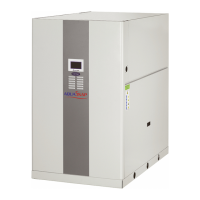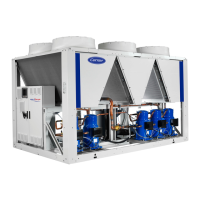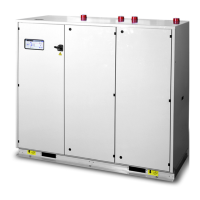49
10 - NOMINAL WATER FLOW CONTROL WITH FIXED-SPEED PUMP
10.1 - General
The water circulation pumps of the units have been sized to allow
the hydraulic modules to cover all possible congurations based
on the specic installation conditions, i.e. for various temperature
differences between the entering and the leaving water (∆T) at full
load, which can vary between 2.5 and 7 K for evaporators and 3
and 18 K for condensers.
This required difference between the entering and leaving water
temperature determines the nominal system ow rate. It is above
all absolutely necessary to know the nominal system ow rate to
allow its control via a manual valve.
Manual control valves for the unit are not supplied and must be
installed upstream and downstream of the evaporator and
condenser water loops to ensure correct ow control.
With the pressure loss generated by the control valve in the
hydraulic system, the valve is able to impose the system pressure/
ow curve on the pump pressure/ow curve, to obtain the desired
operating point (see example).
The pressure drop reading in the plate heat exchanger is used to
control and adjust the nominal system ow rate. The pressure
drop is measured with the pressure sensors connected to the heat
exchanger water inlet and outlet.
Use this specication for the unit selection to know the system
operating conditions and to deduce the nominal air ow as well
as the plate heat exchanger pressure drop at the specified
conditions. If this information is not available at the system start-
up, contact the technical service department responsible for the
installation to get it.
These characteristics can be obtained from the technical literature
using the unit performance tables or the Electronic Catalogue
selection program for all conditions.
10.2 - Water ow control procedure
As the total system pressure drop is not known exactly at the
start-up, the water ow rate must be adjusted with the control valve
to obtain the specic ow rate for this application.
Proceed as follows:
- Open the valve fully.
- Start-up the pump using the forced start command (refer to
the controls manual) and let the pump run for two consecutive
hours to clean the hydraulic circuit of the system (presence
of solid contaminants).
- Read the hydraulic module pressure drop by taking the
difference of the readings at the machine connected to the
hydraulic module inlet and outlet. Compare this value after
two hours of operation.
Entering water pressure reading
Leaving water pressure reading
Legend
O Open
F Closed
Water inlet
Water outlet
Pressure gauge
If the pressure drop has increased, this indicates that the screen
lter must be removed and cleaned, as the hydraulic circuit
contains solid particles. In this case, in units with option 293 or
293A, close the shutoff valves at the water inlet and outlet and
remove the screen lter after emptying the hydraulic section of
the unit. In units without option 293 or 293A, clean the screen lter
on hydraulic circuit out of the unit.
Renew, if necessary, to ensure that the lter is not contaminated.
When the circuit is cleaned, read the pressures at the unit (entering
water pressure - leaving water pressure), expressed in kPa to nd
out the plate heat exchanger pressure drop.
Compare the value obtained with the theoretical selection value.
If the pressure drop measured is higher than the value specied
this means that the ow rate in the plate heat exchanger (and thus
in the system) is too high. The pump supplies an excessive ow
rate based on the global pressure drop of the application. In this
case close the control valve one turn and read the new pressure
difference.
Proceed by successively closing the control valve until you obtain
the specic pressure drop that corresponds to the nominal ow
rate at the required unit operating point.
If the system has an excessive pressure drop in relation to the
available static pressure provided by the pump, the resulting water
ow rate will be reduced and the difference between entering and
leaving water temperature of the hydraulic module will be
increased.

